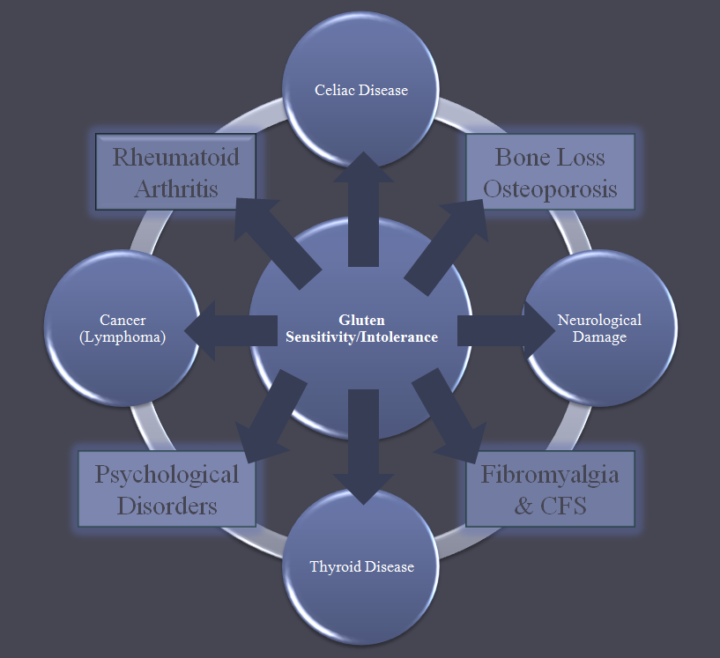Gluten is the common protein molecule found in wheat, barley, rye, kamut and spelt. Gluten is a sticky storage protein that binds to the small intestinal wall where it often causes digestive and immune system disorders. Gluten sensitivity is an epidemic that is a major factor in inflammatory disorders of the gut, immune system, skin and nervous system.
Gluten intolerance is highly associated with inflammatory disorders of all kinds. It is also a contributing factor in many autoimmune diseases such as celiac disease, rheumatoid arthritis, type I diabetes, neurological disorders, Hashimoto’s thyroiditis, autoimmune cardiomyopathy, lymphoma, and dermatitis herpetiformis (skin disease) among others. It is also linked as a contributing factor in asthma, allergies, & excema.
Gluten and the Brain:
Studies have found associations between gluten sensitivity and disorders in every part of the neurological system including the brain, spinal cord and peripheral nerves. Gluten is a significant trigger in psychiatric disorders, movement disorders, sensory ganglionapathy, ataxia, neuromyelitis, multiple sclerosis, cerebellar disease, cognitive impairment, dementia, restless leg syndrome, migraines, apraxia, neuropathy, myoclonus, hearing loss and virtually every other neurological disorder.
For many individuals there immune system gets so overworked from gluten sensitivity and other environmental challenges such as toxins, parasites, vitamin D3 deficiencies and trauma that they can have severe immune reactions that last months after one provoked exposure. This means that consuming gluten on one day can cause an inflammatory assault that could last 2-3 months afterwards. This is why it is so critical to be as strict as possible when avoiding gluten and other inflammatory irritants.
The Complexity of Gluten Sensitivity:
Gluten is made up of a sticky portion called glutenin and a protein portion called gliadin. Gliadin can be broken down into alpha, omega and gamma gliadins. Most lab tests only look at alpha gliadin anti-bodies but this is only a very small compenent of the total molecule. Often times this lab comes back negative but the individual is reacting to some of the other components of the gluten molecule.
Glutenin gives wheat dough strength and elasticity and is very commonly used in the baking process do to these desirable characteristics. Many people have severe reactions to this molecule but it never shows up on the basic gliadin anti-bodytesting.
The food processing industry very often deamidates the gladin molecule to make it water soluble. Deamidated gliadin has been shown to trigger severe immune responses in many individuals. This never tests out for gliadin anti-bodies.
Lectin Sensitivity can Compound Gluten Sensitivity:
Grains, nuts and legumes also contain lectins which bind sugars and carbohydrates together. They are referred to as wheat germ agglutin (WGA) molecules in wheat. The WGA molecules have been shown to trigger immune reactions and their highest concentrations are found in whole wheat and sprouted wheat.
Research has shown that WGA molecules can pass through the blood brain barrier and attach to the myelin sheath which is the protective coating of the nerve. Lectins inhibit nerve growth factor which affects the ability of the nerves to heal and repair effectively. Many individuals never test positive for a gluten allergen yet they have WGA sensitivity that is causing severe inflammatory problems in their body.
Gluten Based Opioids:
When the body metabolizes gluten it creates opoids in the form of gluteomorphin. One can have a blood test to see if the body produces antibodies to gluteomorphin and the building block prodynorphin. When someone has a opioid sensitivity going gluten free can cause severe withdrawal symptoms that are similar to coming off of opioid drugs such as heroin. These symptoms include depression, crazy mood swings, nausea and vomiting as well as abnormal bowel activity. This can often last anywhere from several days to weeks.
Cross-Reactivity Immunology & Nervous System Dysfunction:
Immune cross reactivity happens when the immune system mistakes one protein for another. The gluten protein is similar to protein structures in the nervous system and the thyroid tissue. When the body creates anti-bodies for gluten it may also produce anti-bodies to the body’s own nervous tissue or thyroid. This cross-reactive effect leads to damage to the brain, thyroid and other neurological tissue when the individual consumes anything with even the slightest bit of gluten.
The best test for gluten cross-reactivity is the ELISA. This is a blood test in which the blood is placed in a dish with various neurological tissues and later inspected for an immune response. If the immune response is elevated it is evidence of such a cross-reactive immune response.
The most common area of cross reactivity is through a family of proteins located on neurons called synapsin. These proteins help to regulate neurotransmitter release. This is most common in the cerebellum which can cause problems with vertigo, motor control, balance and anxiety.
Transglutaminase AutoImmunity:
Transglutaminases are enzymes found throughout the body that bind proteins together and they are also key to the digestion of wheat. Transglutaminase-2 (TG-2) is found in the intestinal lining and anti-bodies to TG-2 are a marker for celiac disease. Transglutaminase-3 (TG-3) are found in the skin and anti-bodies can lead to chronic acne, eczema and dermatitis. Transglutaminase-6 (TG-6) is found throughout the central nervous system and antibody formation leads to neurological disorders.
Transglutaminase enzymes are also used by the food industry to tenderize meat to hold processed meats together in specific shapes. Individuals with transglutaminase reactivity would have significant reactions when they consume these processed meats as well.
Gluten Reacts with the Blood-Brain Barrier:
The inflammatory reaction to gluten deteriorates the thin lining that protects the brain from pathogens and environmental toxins. This only increases auto-immune reactions and chronic inflammatory damage in the brain. This also creates a pathway for heavy metals like aluminum to get into the brain. Aluminum amyloid plaques are classically found in the temporal lobe with Alzheimer’s disease.
The Complete Gluten AntiBody Screening:
The following factors should be tested first before anyone should think about consuming gluten containing food sources:
- Gliadin – Alpha, Omega & Gamma
- Deamidated Gliadin
- Wheat Germ Agglutin (WGA)
- Gluteomorphin & Prodynorphin
- TGA-2, TGA-3, TGA-6
- *This is the Wheat/Gluten Proteome Sensitivity and Autoimmunity Panel through Cyrex Labs*
Sources of Gluten:
- Wheat Spelt Barley Kamut Rye
- Oats (except from a gluten-free oat farm)
Foods Suspected Cross-React with Gluten by the Immune System:
- Alpha Casein
- Beta Casein A1
- Canola
- Coffee-“Instant”
- Corn
- Egg Protein
- Milk chocolate
- Millet
- Oats
- Peanut
- Potato
- Rice
- Sesame
- Soy
- Whey Protein
- Yeast
Hidden Sources of Gluten:
- Artificial Food Coloring
- Clarifying Agents
- Dextrins
- Food Emulsifiers
- Food Stabilizers
- Modified Food Starch
- Malt Extract
Commonly Overlooked Sources of Gluten:
Processed Condiments (ketchup, mustard & salad dressings)
Deli Meats Beer Soy Sauce Imitation Crab Meats Shampoos
Going Beyond Gluten-Free:
For most individuals with a gluten intolerance going gluten-free alone is not enough. Clinically, I see many of these individuals do better going gluten-free but they continue to have digestive and neurological struggles until they remove grains, legumes, most dairy (fermented raw dairy from A2 beta casein producing cows is usually tolerable) and nuts. This removes lectins which can be very inflammatory for individuals with compromised digestive systems and immune imbalances.
Often these individuals have severely compromised digestive systems from years of inflammatory assault on the villi of the small intestine. Many of these individuals will need to do an advanced leaky gut cleanse to get over the hump.
Sources For This Article Include:
Datis Kharrazian, Why Isn’t My Brain Working. Elephant Press. 2013.
http://www.drjockers.com/2012/07/gluten-the-inflammatory-molecule-in-bread/
http://www.drjockers.com/2012/11/beat-multiple-sclerosis-naturally/
http://www.sott.net/article/261516-Bread-madness-schizophrenia-or-gluten-sensitivity




